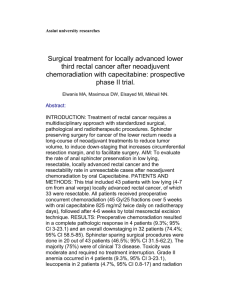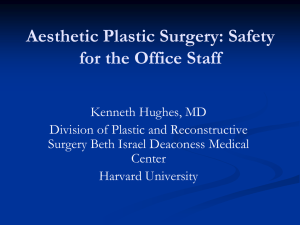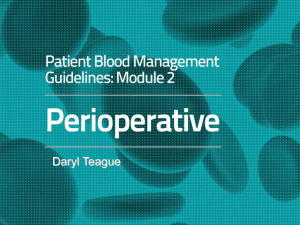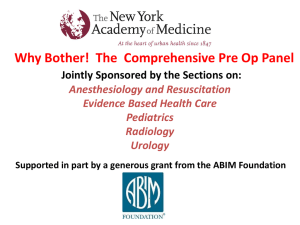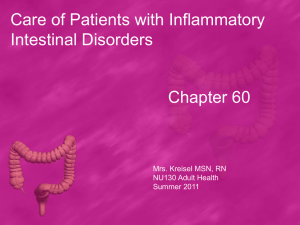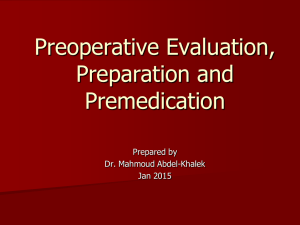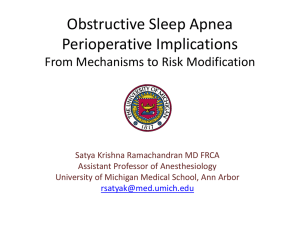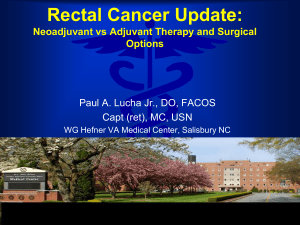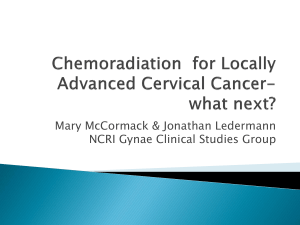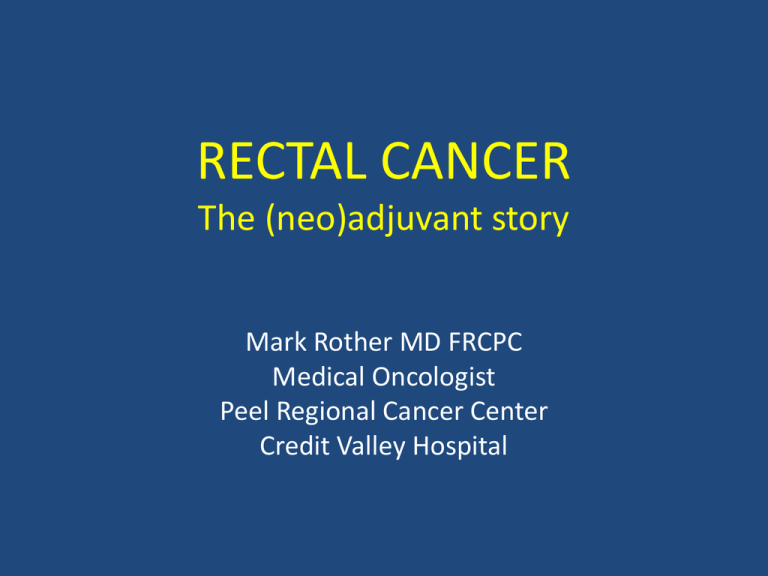
RECTAL CANCER
The (neo)adjuvant story
Mark Rother MD FRCPC
Medical Oncologist
Peel Regional Cancer Center
Credit Valley Hospital
Case
• 62 year old man (father of your life long best friend)
has rectal bleeding
• You get him in to see a GI specialist and a
colonoscopy finds a non obstructing adenocarcinoma
6 cms from anal verge
• CT Thorax/Abd/Pelvis – No mets
• Your friend calls you for advice on the next step? He
has been reading up!
• He thinks his Dad will need surgery, chemo and
radiation based on his reading
• He finds it all very confusing but knows you are an
expert in GI oncology and will clarify it for him and
his dad.
Questions?
• More Tests- MRI? EUS? Role of PET/CT?
• Surgery- When? What type? Who should do it?
• Radiation- Before/After surgery? Long protracted or
intensive short type? With chemo or without?
• Chemotherapy- What type? How long for? New
drugs? Clinical trials? Must he get a PICC?
OVERVIEW
•
•
•
•
•
•
•
•
Introduction
Postoperative Chemoradiation
Preoperative Radiotherapy(no chemo)
Preoperative Chemoradiation
Preoperative vs Postoperative Chemoradiation
Optimizing Preoperative Chemoradiation
Postoperative chemotherapy after neoadjuvant CRT
Future Approaches
OVERVIEW
•
•
•
•
•
•
•
•
Introduction
Postoperative Chemoradiation
Preoperative Radiotherapy(no chemo)
Preoperative Chemoradiation
Preoperative vs Postoperative Chemoradiation
Optimizing Preoperative Chemoradiation
Postoperative chemotherapy after neoadjuvant CRT
Future Approaches
Rectal Cancer
• Estimated 6000 new cases per year in Canada
(30% of colorectal cancer)
• Local and Systemic Relapse Risk
• Prototype of a multimodality approach
– Surgery
– Radiation
– Chemotherapy
Definition- Rectal Cancer
• Discriminating between colon and rectal cancer is
critical
• Colon is 150 cm long but rectum is about the last
12-15 cm
• Anatomically, the upper boundary of the rectum
is located at the rectosigmoid junction, slightly
below the sacral promontory. On clinical grounds,
the peritoneal reflection is the more important
landmark
Definition - Rectal Cancer
• In the post-operative setting the location of
the tumour relative to the peritoneal
reflection should be part of the surgical and
pathological report
• Identification of rectal tumours prior to
surgery is generally obtained by measuring the
distance between the inferior edge of the
tumour and the anal verge(12-15cm)
Adjuvant therapy
• Adjuvant therapy needs to address the local
and systemic recurrence risk
• Under-treatment : pelvic recurrences and
complications
• Over-treatment : therapy related complications
- bowel, bladder and sexual dysfunction
Challenges in Adjuvant Therapy for Rectal Cancer
• Data from randomized trials limited.
• Debate on pre vs post op radiation and radiation dose and
schedule is confusing
• Chemotherapy concurrently with XRT-What and How?
• Decisions on adjuvant chemo if received pre-op therapy.
OVERVIEW
•
•
•
•
•
•
•
•
Introduction
Postoperative Chemoradiation
Preoperative Radiotherapy(no chemo)
Preoperative Chemoradiation
Preoperative vs Postoperative Chemoradiation
Optimizing Preoperative Chemoradiation
Postoperative chemotherapy after neoadjuvant CRT
Future Approaches
OLDER APPROACH TO RECTAL CANCER
(but still commonly done)
• Surgical resection
• Pathology assessment and risk estimation
• Treatment based on TMN
• Post operative Chemoradiation
1990 NCI Consensus Statement
• Combined postoperative chemotherapy and
radiation improves local control and survival in
patients with stage II and III rectal cancer and
is recommended:
– GITSG
– NCCTG-MAYO
JAMA 1990: 264:1444-1450
1990 NCI Consensus Statement
GITSG
(227)
NEJM
1985
Surgery/5FU/mCCNU/RT
NCCTG
(204)
NEJM
1991
Surgery/5FU/mCCNU/RT
LR 11%
OS 56%
LR 14%
OS 58%
Surgery/5FU/mCCNU
LR 21%
OS 46%
Surgery/RT
LR 25%
OS 48%
Surgery/RT
LR 20%
OS 43%
Surgery
LR 24%
OS 32%
NCCTG Intergroup Study
• 660 patients with resected stage II/III rectal
cancer
O’Connell NEJM 1994
NCCTG Intergroup Trial
2x2 study design:
PVI 5-FU vs bolus(with rads)
- Improved PFS (p=0.02)
- Improved OS (p=.01)
MeCCNU: no benefit
O’Connell NEJM 1994
Intergroup 0114 : Post-operative CT – CRT- CT
Bolus 5FU
II
III
R
Bolus 5FU-Levamisole
Bolus 5FU-Leucovorin
Bolus 5FU-Leucovorin-Levamisole
Tepper et al. JCO 2002
CP1050909-25
Intergroup 0114 -OS by treatment arm
Tepper, J.E. et al. J Clin Oncol; 20:1744-1750 2002
Intergroup 0144: Post operative CT – CRT - CT
b5FU – XRT+PVI5FU – b5FU
II
III
R
PVI5FU – XRT+PVI5FU – PVI5FU
b5FU/LV – XRT+b5FU/LV – b5FU/LV
Smalley, JCO2006
Intergroup 0144 - Overall survival and relapse-free survival
Smalley, S. R. et al. J Clin Oncol; 24:3542-3547 2006
Advantages of Postoperative Treatment
• Accurate pathologic staging
• Shorter delay to definitive surgery
• Potentially less surgical morbidity?
– Not complicated by prior XRT-chemo
Long-Term Effects of Postoperative Chemoradiation
Surgery alone
Chemoradiation
# BMs/day
2 (1-7)
7 (1-20)
Nocturnal BMs
18%
46%
Continence
93%
44%
5%
53%
Antidiarrheals
OVERVIEW
•
•
•
•
•
•
•
•
Introduction
Postoperative Chemoradiation
Preoperative Radiotherapy(no chemo)
Preoperative Chemoradiation
Preoperative vs Postoperative Chemoradiation
Optimizing Preoperative Chemoradiation
Postoperative chemotherapy after neoadjuvant CRT
Future Approaches
Swedish Rectal Cancer Study
Preop RT
(25 Gy in 5 fractions)
R
LR 11%, 5yr OS 58%
Immediate surgery
LR 27%, 5yr OS 48%
NEJM 1997
Dutch Colorectal Group (NEJM 2001)
Preop RT + TME
(25 Gy in 5 fractions)
R
LR 5.6%
TME alone
LR 10.9%
Kapiteijn NEJM 2001
MRC CR-07 (NCIC CO-16)
Lancet 2009; 373: 821–28
Lancet 2009; 373: 821–28
MRC CR07
Lancet 2009; 373: 821–28
MRC CR07
What about Short-course XRT?
• 2500 cGy in 5 fractions
• Northern Europe approach
• No concurrent chemo(5FU) radiosensitizer
• Surgery within a 1-2 weeks
• No downstaging(not for T4 or concern re CRM)
• Concerns re long term bowel function
• Studies ongoing with 6 week delay(?downstaging)-Stockholm lll
OVERVIEW
•
•
•
•
•
•
•
•
Introduction
Postoperative Chemoradiation
Preoperative Radiotherapy(no chemo)
Preoperative Chemoradiation
Preoperative vs Postoperative Chemoradiation
Optimizing Preoperative Chemoradiation
Postoperative chemotherapy after neoadjuvant CRT
Future Approaches
Preoperative Chemoradiotherapy
•North American/Southern Europe approach
•For patients with locally advanced disease
-T3/T4 or N+
•More protracted RT course 5-6 weeks(45-50.4 cGy)
•Concurrent 5FU based chemotherapy
•Followed by Surgery 4 - 6 weeks later
Bosset NEJM 2006
Bosset NEJM 2006
Polish Study Results
• 25/5 vs Chemoradiation Therapy
• pCR 1% vs. 19%
• Similar SSS,DFS,OS
• Similar late toxicity
• Await similar design TROG study
TROG Study-ASCO 2010
OVERVIEW
•
•
•
•
•
•
•
•
Introduction
Postoperative Chemoradiation
Preoperative Radiotherapy(no chemo)
Preoperative Chemoradiation
Preoperative vs Postoperative Chemoradiation
Optimizing Preoperative Chemoradiation
Postoperative chemotherapy after neoadjuvant CRT
Future Approaches
• INT- 0147
- terminated prematurely due to poor accrual
• NSABP R-03
- terminated prematurely due to poor accrual
• German Trial- CAO/ARO/AIO 94
- completed accrual
Volume 351:1731-1740 October 2004
Preoperative versus Postoperative
Chemoradiotherapy for Rectal Cancer
Rolf Sauer, M.D., Heinz Becker, M.D., et al. for the German Rectal Cancer Study Group
Results -Preoperative versus Postoperative
Chemoradiotherapy for Rectal Cancer
Rolf Sauer, M.D., Heinz Becker, M.D., et al. for the German Rectal Cancer Study Group
• 421 receive preoperative and 402 receive postoperative
chemoradiotherapy.
• The overall five-year survival rates were 76 percent and 74 percent
(P=0.80).
• The five-year incidence of local relapse 6 percent for preoperative and 13
percent in the postoperative group (P=0.006).
• Grade 3 or 4 acute toxicity occurred in 27 percent of the patients in the
preoperative-treatment group, as compared with 40 percent of the patients
in the postoperative-treatment group (P=0.001)
Sauer NEJM 2004
Sauer NEJM
2004
Sauer
NEJM 2004
Sauer NEJM 2004
Sphincter Preserving Surgery
ITT Analysis
Postoper. RCT
n= 394
Pre-randomization:
“APR Necessary“
Sphincter
preserved
APR actually done
Preoper. RCT
n = 405
85
17/85 (20%)
85-17= 68
109
p = 0.004
43/109 (39%)
109-43= 66
German Rectal Study Conclusions
• Preop CRT significantly improves local control
• Preop CRT improves sphincter preservation in
low-lying tumours
• Preop CRT reduced acute and chronic toxicity
• Preop CRT should be the standard adjuvant
treatment in cT3/4 or cN+ rectal cancer
CAVEAT
• 18% of tumours in the post operative group
were overstaged clinically (i.e. Stage 1 on
pathology)
• Mandates excellent preoperative radiologic
assessment
Preoperative Rectal Staging
Accurate preoperative local tumor staging is critical in directing patient management
All modalities remain poor in assessment of regional lymph node involvement
CT still the workhorse for distant metastatic disease, complications/sequelae and
surveillance
OVERVIEW
•
•
•
•
•
•
•
•
Introduction
Postoperative Chemoradiation
Preoperative Radiotherapy(no chemo)
Preoperative Chemoradiation
Preoperative vs Postoperative Chemoradiation
Optimizing Preoperative Chemoradiation
Postoperative chemotherapy after neoadjuvant CRT
Future Approaches
5FU as a radiosensitizer
• Improves local control, pCR (FFCD,EORTC)
• Potentially improves control at distant sites
(treats micro metastasis earlier)
• PVI is the optimal schedule
Capecitabine as a Radiosensitizer?
• Mimics infusional 5FU
• Convenient versus PVI
• Intratumoral thymidine phosphorylase activity
upregulated with XRT
Oral vs Infusional 5FU
N
PCR (%)
SSS (%)
Phase2, UFT 400mg/m2/d X 5/7
– S – 5FU/LVX4 (1)
94
9%
25%
Phase1 – RP2D Capecitabine
825mg/m2 BID X 7/7 (2)
36
--
--
Phase 2, Capecitabine
825mg/m2 BID X 7/7 – S – C X
4/12 (3)
53
24%
59%
Phase 2, Capecitabine
825mg/m2 BID X 7/7 – S – C X
4/12 (4)
95
12%
74%
Matched-Pair Analysis (PVI vs
Capecitabine) (5)
89/89
12%/21%
70%/78%
Similar OS
1 – Fernandez, JCO2004 2 – Dunst, JCO 2002
3 – DePaoli, Ann Oncol 2006 4 – Kim, IJROBP 2005
5 – Das, IJROBP, 2006
Capecitabine versus 5-fluorouracil-based
(neo-)adjuvant chemo-radiotherapy
for locally advanced rectal cancer:
Long term results of a randomized phase III trial
R. Hofheinz, F. Wenz, S. Post, on behalf of the German MARGIT study
Study Design
Mar 2002-July2005
Post-Op
Treatment
Post July 2005
After Publication
of Sauer Trial
Neoadjuvant
Treatment
Arms Added
Overall survival (OS)
Primary endpoint (Median Follow-up 52 mon.)
Disease free survival (DFS)
Secondary endpoint (Median Follow-up 52 mon.)
NSABP-R04
No Oxaliplatin
Oxaliplatin
1200 pts
5FU
Capecitabine
***Capecitabine is 825 mg /m2 bid for 5/7(Rad days)
Roh et al ASCO 2011
NSABP-R04
Roh et al ASCO 2011
NSABP-R04
Roh et al ASCO 2011
5FU-Oxaliplatin-XRT
•Over 15 phase I/II trials have demonstrated pCR rates
ranging from 20-40% (compared to 10-20% expected with
XRT+5-FU)
•Increased likelihood for sphincter preservation?
•More efficacious systemic therapy for micrometastases
given preoperatively?
NSABP-R04
Roh et al ASCO 2011
NSABP-R04
Pathologic Complete Response by Treatment
Oxaliplatin vs None
Sphincter Saving Surgery by Treatment
Oxaliplatin vs None
Roh et al ASCO 2011
STAR TRIAL
Aschele C et al. J Clin Oncol July 2011
STAR TRIAL RESULTS
5-FU CRT
5-FU/Oxal CRT
p-value
Path CR
16%
16%
0.94
Gr 3-4 toxicity
Any
Diarrhea
8%
4%
24%
15%
<0.0001
<0.0001
0.5%
36%
<0.0001
Grade 2-3
neurosensory
Aschele C et al. J Clin Oncol July 2011
ACCORD 12/0405-Prodige 2
Eligibility
• T3-4, N0-2, M0 resectable (or T2 distal anterior)
rectal cancer, DRE accessible
R
CAPE/RT45
RT 45 Gy x 5 wks
CAPE 800 mg/m2 BID/day*
CAPOX/RT50
RT 50 Gy x 5 wks
CAPE 800 mg/m2 BID/day*
OXA 50 mg/m2 weekly
(6 weeks)
*Except weekend
Total Mesorectal Excision (TME)
Adjuvant chemotherapy (Center discretion)
Gerard JP et al. J Clin Oncol 2010;28(10):1638-44.
ACCORD 12 TRIAL RESULTS
CAP/RT
CAPOX/RT
p-value
Path CR
14%
19%
0.11
Gr 3-4 toxicity
Any
Diarrhea
Neuropathy
11%
3%
0.4%
25%
13%
5%
<0.001
<0.001
<0.002
Standard of care remains 5-FU based neoadjuvant CRT without oxaliplatin.
Gerard JP et al. J Clin Oncol 2010;28(10):1638-44.
OVERVIEW
•
•
•
•
•
•
•
•
Introduction
Postoperative Chemoradiation
Preoperative Radiotherapy(no chemo)
Preoperative Chemoradiation
Preoperative vs Postoperative Chemoradiation
Optimizing Preoperative Chemoradiation
Postoperative chemotherapy after neoadjuvant CRT
Future Approaches
Decline in the rates of local failure:1980-2010
The war we are winning
35
Local failure (%)
30
25
20
15
10
5
0
sx only
sx RT
sx CTRT
CTRT TME
Distant metastases (%)
Deline in the rates of distant failures: 1980-2010
The war we are losing
40
35
30
25
20
15
10
5
0
sx only
sx RT
sx CTRT
CTRT TME
Postoperative chemotherapy in Rectal Cancer
(no preoperative treatment in these studies)
(NCCTG 794751, 864751; NSABP R01, R02; INT 0114)
n=3791
CT
No CT
Gunderson, L. L. et al. J Clin Oncol; 22:1785-1796 2004
Postoperative chemotherapy in Rectal Cancer
QUASAR STUDY-Rectal Cohort(29%) n=948
Recurrence free survival
Overall survival
Lancet 2007 Lancet 2007; 370: 2020–29; 370: 2020–29
Postoperative chemotherapy in Rectal Cancer
ECOG 3201
5FU/LV
Stage II/II
Rectal Cancer
R
FOLFOX4
Preop or Postop CRT
(MD Choice)
FOLFIRI
Closed at 225 of planned 3150
Bosset NEJM 2006
Bosset NEJM 2006
Who benefits from post operative 5FU?
(ypT downsized)
Collette, L. et al. J Clin Oncol; 25:4379-4386 2007
Postoperative chemotherapy after neoadjuvant CRT
5FU/FA:
-Only trend in EORTC study(negative)-Only level 1 study to date
-Standard in postoperative CRT era-QUASAR,INT 0114/0144
Xeloda:
-Only extrapolation from stage 3 colon cancer(X-ACT)
FOLFOX:
-Only extrapolation from stage 3 colon cancer(MOSAIC,CO7)
Postoperative chemotherapy after neoadjuvant CRT
• All patients should get some chemo regardless of ypT
ypN statusplan set preoperatively
• Duration should be 4 months
• Choice of Xeloda vs FOLFOX individualized
• If no downstaging- FOLFOX?
• If short-course preop-XRT – 6 months
STUDIES OF CHEMOTHERAPY IN RECTAL CANCER
Pre-op:
STAR( 5FU +/- OXALIPLATIN)-Published JCO 2011
ACCORD(XELODA +/- OXALIPLATIN)- Published JCO 2010
NASBP R-04( 5FU vs. XELODA +/- OXALIPLATIN)-ASCO 2011
Post-op:
SCRIPT (XELODA vs. Nil)-Closed for accrual issues
CHRONICLE (XELOX vs. Nil)- Closed for accrual issues
E5204 (FOLFOX +/-AVASTIN)- Closed for accrual issues
Pre and Post-op:
CAO/ARO/AIO 04(5FU+/-Oxaliplatin---PRE/POST)- report 2011
PETACC-6(XELODA +/- OXALIPATIN---PRE/POST)-ongoing
SCRIPT STUDY
Operable Rectal Cancer-Clinical Stage2/3
↓
Preop CRT/5 day rads
↓
TME surgery
↓
Randomization
Observation
Capecitabine
CLOSED DUE TO POOR ACCRUAL
CHRONICLE STUDY
CLOSED DUE TO POOR ACCRUAL
ECOG 5204 Phase III Trial (NCIC CRC.4)
mFOLFOX6 X 12
Stage II/III
R
mFOLFOX6 + Bev X 12
Accrual: 2100 planned- CLOSED DUE TO ACCRUAL -2009
CAO/ARO/AIO 04
Rodel et al ASCO 2011
CAO/ARO/AIO 04
Rodel et al ASCO 2011
CAO/ARO/AIO 04
Rodel et al ASCO 2011
CAO/ARO/AIO 04
Conclusion
Rodel et al ASCO 2011
PETACC 6
ONGOING
OVERVIEW
•
•
•
•
•
•
•
•
Introduction
Postoperative Chemoradiation
Preoperative Radiotherapy(no chemo)
Preoperative Chemoradiation
Preoperative vs Postoperative Chemoradiation
Optimizing Preoperative Chemoradiation
Post operative adjuvant chemotherapy
Future Approaches
Newer approaches-Phase 2
Newer approaches-Phase 2
Newer approaches-Phase 2
EXPERT trial
Newer approaches-Phase 2
Newer approaches-Phase 2
Newer approaches-Phase 2
Newer approaches-Phase 2
Newer approaches-Phase 2
Newly diagnosed
clinical stage II or III
rectal adenocarinoma
FOLFOX + Bev
FOLFOX + Bev x 4
FOLFOX x 2
Patients with
progressive or
stable disease
XRT + 5-FU
Patients with
clinical regression
Surgery*
*Post-operative treatment at
discretion of physician.
FOLFOX x 6 recommended; no
post-operative Bev provided.
Schrag D et al. Proc ASCO 2010;Abstract 3511.
Newer approaches-Phase 2
• 31 patients with Stage II/III (no T4) rectal
• 27/27 patients had regression and proceeded
to surgery with no XRT
• 27 had R0 resection and 7/27 (26%) pCR
• One pt with 14/14 nodes offered post-op XRT
Schrag D et al. Proc ASCO 2010;Abstract 3511.
CALGB Phase II/III “PROSPECT” study
Newer approaches-Phase 2
SUMMARY
APPROACH TO RECTAL CANCER-2011
• Accurate preoperative imaging -MRI Staging
• Multidisciplinary Tumour Board discussion
• Use of preoperative radiation with or without
chemotherapy
• Surgical concept of TME resections
• Pathologists “auditing” the surgical procedure
-TME quality, CRM, nodal recovery
• Postoperative chemotherapy
Questions

